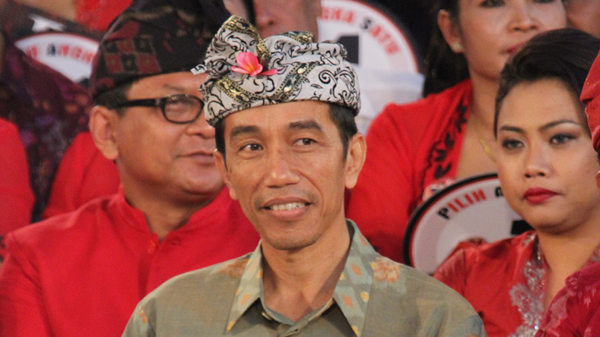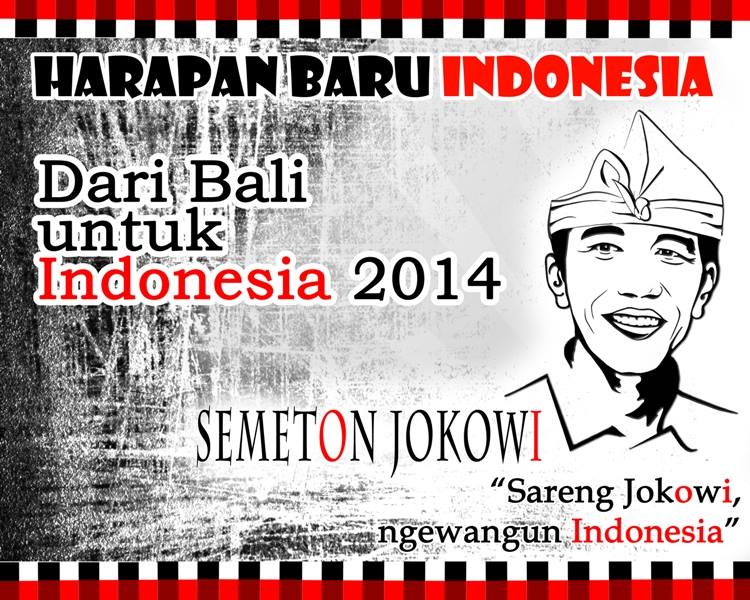The news of Joko Widodo’s nomination as the presidential candidate for the PDIP has been received with great fanfare throughout Indonesia. In response to news of Jokowi’s nomination the Indonesian Stock Exchange, the Jakarta Composite Index rose by 3.23 %. Social media users have issued a euphoric response to the prospect of a Jokowi presidency. Several days after the announcement of his candidacy, the topic was still trending on Facebook and Twitter. A number of users have adopted the official PDIP logo, #JKW4P, as their avatar on social media.
This euphoric response was no less felt in Bali. Even before the official announcement was made, red banners appeared in the streets of Denpasar in support of Jokowi’s presidential bid. The Balinese even claimed Jokowi as their own when they established a Facebook group called Semeton Jokowi, meaning The Jokowi Family, and adorned it with a cover photo of Jokowi smiling broadly and wearing a Balinese style udeng head-dress. Early this week a flurry of banners suddenly appeared along Denpasar streetsides, calling on voters to “Vote -4 Jokowi for President”.
It is likely that Jokowi’s nomination will reignite the enthusiasm of members and supporters of the PDIP in Bali after hopes of winning provincial elections were dashed last year, when incumbent Made Mangku Pastika narrowly defeated his former vice governor, Anak Agung Puspayoga.
Traditionally, Balinese voters have strongly supported nationalist parties. IN the 1955 national elections, most Balinese voted for the PNI, followed by the PSI and the PKI. Islamic parties have never really gained a foothold on the island where the majority are Hindu. As was common across the country in the New Order period, Golkar was returned with resounding majorities by Balinese voters in 1977 (85%), 1982 (88%), 1987 (88%) and 1992 (78%). In those years, the remaining votes were for the PDIP.
This pattern completely turned around after 1998. In the first national elections in the post-New Order period in 1999, the PDIP won 77.81 % of votes in the Balinese legislature, and Bali quickly became recognised as a hotbed of fervent support for the PDIP, partly as a result of Megawati Soekarnoputri’s Balinese ancestry.
But over the last five years, Balinese support for the PDIP has declined drastically. In the national elections of 2004, the PDIP won 51.32% of votes (and 30 of 55 seats in the legislature). In the 2009 elections this figure dropped further to only 38% of votes (and 24 of 55 seats). An exception to this decline of the PDIP vote in Bali is the 2008 Balinese gubernatorial elections, where the PDIP’s gubernatorial-vice gubernatorial pair, Made Mangku Pastika and Anak Agung Puspayoga won 55% of the vote.
In the 2013 gubernatorial election, however, the pair competed against one another for the governorship, with Puspayoga as the PDIP’s candidate and Pastika supported by a coalition of nine parties including Golkar and the Demokrat Party. Jokowi, then as Jakarta governor but already widely touted as a possible PDIP presidential candidate, campaigned in Bali for Puspayoga to no avail..Pastika was narrowly returned anyway.
It is true, however, that most Balinese district heads are PDIP. Out of 8 Bupatis, 5 Bupatis are from the PDIP, with the remaining two being from Golkar and Partai Demokrat. But electoral results at the provincial level in recent years show that the Balinese electorate is increasingly fluid and cannot be counted on to consistently support the PDIP. The question on everyone’s lips is, will Jokowi’s nomination re-establish PDIP dominance in the Balinese regional legislature?
………………………
Anton Muhajir is a journalist, editor and blogger from Bali.
 Facebook
Facebook  Twitter
Twitter  Soundcloud
Soundcloud  Youtube
Youtube  Rss
Rss 
